D-link DGS-1500-28, DGS-1500-28P, DGS-1500-20, DGS-1500-52 Manual
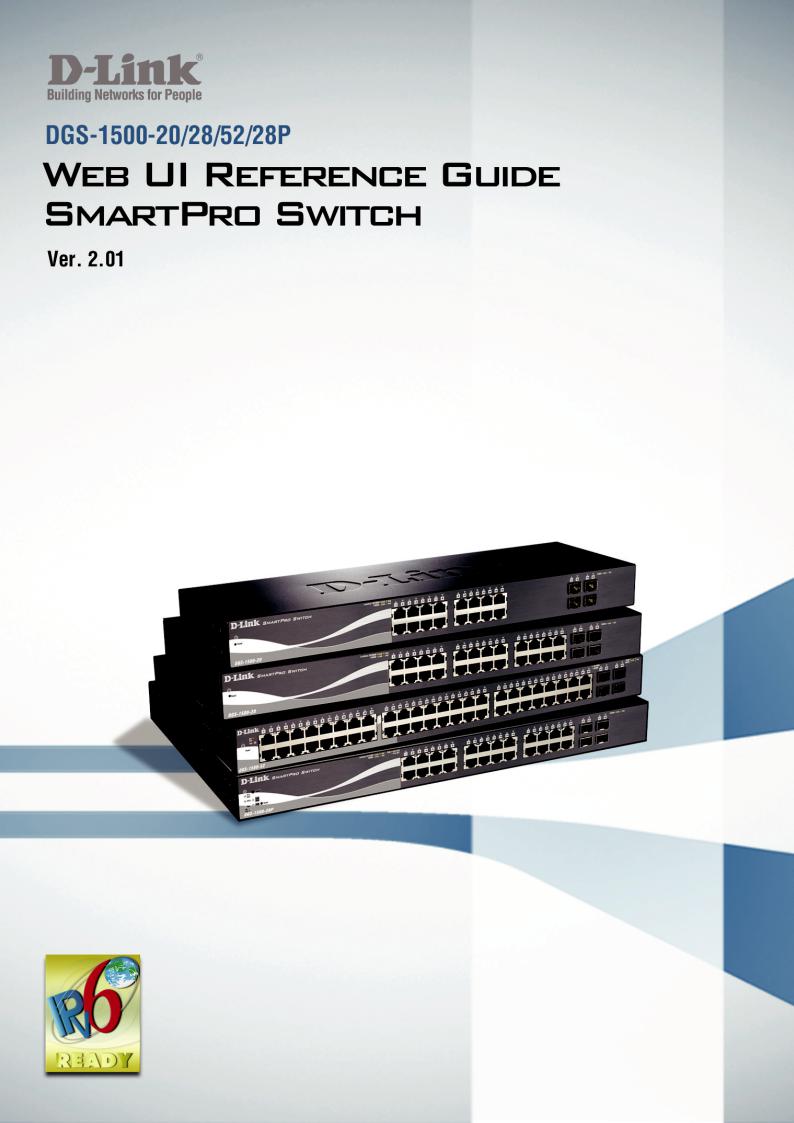
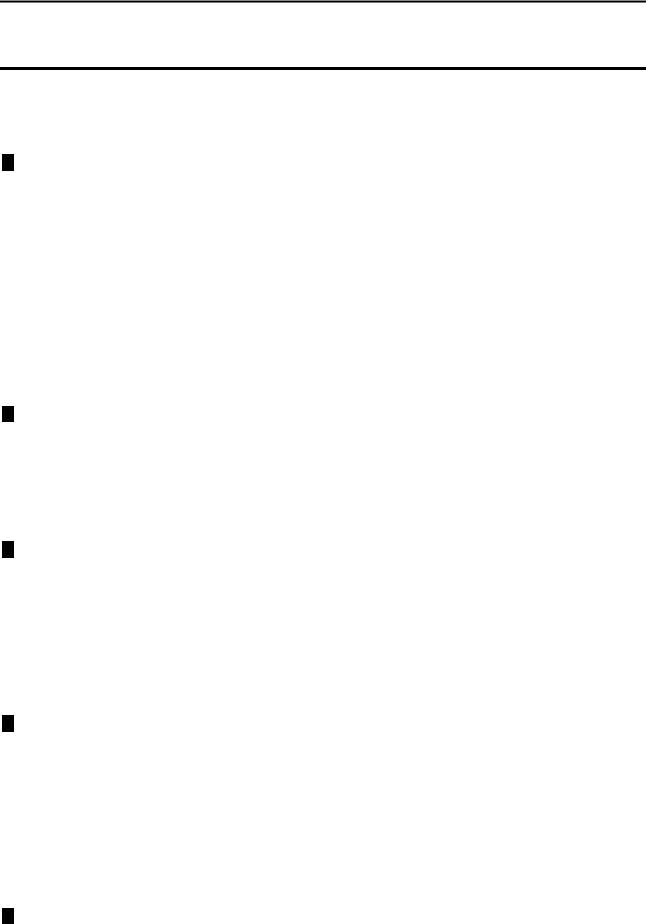
Table of Contents |
D-Link Web Smart Switch User Manual |
Table of Contents |
|
Table of Contents ............................................................................................................................................. |
i |
About This Guide............................................................................................................................................. |
1 |
Terms/Usage.................................................................................................................................................. |
1 |
Copyright and Trademarks ............................................................................................................................ |
1 |
Product Introduction ................................................................................................................................... |
2 |
DGS-1500-20 ................................................................................................................................................. |
3 |
Front Panel ................................................................................................................................................. |
3 |
Rear Panel.................................................................................................................................................. |
3 |
DGS-1500-28 ................................................................................................................................................. |
3 |
Front Panel ................................................................................................................................................. |
3 |
Rear Panel.................................................................................................................................................. |
4 |
DGS-1500-28P............................................................................................................................................... |
4 |
Front Panel ................................................................................................................................................. |
4 |
Rear Panel.................................................................................................................................................. |
5 |
DGS-1500-52 ................................................................................................................................................. |
5 |
Front Panel ................................................................................................................................................. |
5 |
Rear Panel.................................................................................................................................................. |
5 |
Hardware Installation .................................................................................................................................. |
6 |
Step 1: Unpacking.......................................................................................................................................... |
6 |
Step 2: Switch Installation .............................................................................................................................. |
6 |
Desktop or Shelf Installation....................................................................................................................... |
6 |
Rack Installation ......................................................................................................................................... |
6 |
Step 3 – Plugging in the AC Power Cord....................................................................................................... |
7 |
Power Failure ............................................................................................................................................. |
8 |
Getting Started............................................................................................................................................. |
9 |
Management Options..................................................................................................................................... |
9 |
Using Web-based Management .................................................................................................................... |
9 |
Supported Web Browsers .......................................................................................................................... |
9 |
Connecting to the Switch............................................................................................................................ |
9 |
Login Web-based Management ............................................................................................................... |
10 |
Smart Wizard ............................................................................................................................................... |
10 |
Web-based Management............................................................................................................................. |
10 |
SmartConsole Utility..................................................................................................................................... |
10 |
SmartConsole Utility ................................................................................................................................. |
12 |
SmartConsole Settings ................................................................................................................................ |
12 |
Utility Settings........................................................................................................................................... |
12 |
Log............................................................................................................................................................ |
12 |
Trap .......................................................................................................................................................... |
13 |
Monitor List ............................................................................................................................................... |
13 |
About ........................................................................................................................................................ |
14 |
Device Configuration.................................................................................................................................... |
14 |
Add(+), Delete(-) and Discover the device ............................................................................................... |
16 |
Device List.................................................................................................................................................... |
17 |
Configuration ............................................................................................................................................. |
19 |
Smart Wizard Configuration......................................................................................................................... |
19 |
IPv4 Information ....................................................................................................................................... |
19 |
Password Settings.................................................................................................................................... |
19 |
|
i |
Table of Contents |
D-Link Web Smart Switch User Manual |
SNMP Settings ......................................................................................................................................... |
20 |
|
Web-based Management ......................................................................................................................... |
21 |
|
Tool Bar > Save Menu ................................................................................................................................. |
22 |
|
Save Configuration................................................................................................................................... |
22 |
|
Save Log .................................................................................................................................................. |
22 |
|
Tool Bar > Tool Menu .................................................................................................................................. |
22 |
|
Reset ........................................................................................................................................................ |
22 |
|
Reset System ........................................................................................................................................... |
22 |
|
Reboot Device .......................................................................................................................................... |
23 |
|
Configuration Backup and Restore .......................................................................................................... |
23 |
|
Firmware Backup and Upgrade................................................................................................................ |
23 |
|
Tool Bar > Smart Wizard.............................................................................................................................. |
24 |
|
Tool Bar > Online Help................................................................................................................................. |
24 |
|
Function Tree ............................................................................................................................................... |
26 |
|
Device Information.................................................................................................................................... |
26 |
|
System > System Settings ....................................................................................................................... |
27 |
|
System > Password.................................................................................................................................. |
28 |
|
System > Port Settings............................................................................................................................. |
28 |
|
System > DHCP Auto Configuration ........................................................................................................ |
29 |
|
System > SysLog Host Settings............................................................................................................... |
30 |
|
System > Time Profile .............................................................................................................................. |
30 |
|
System > Power Saving ........................................................................................................................... |
31 |
|
System > IEEE802.3az EEE settings....................................................................................................... |
31 |
|
VLAN > 802.1Q VLAN.............................................................................................................................. |
32 |
|
VLAN > VLAN Status ............................................................................................................................... |
33 |
|
VLAN > GVRP > GVRP Global Settings.................................................................................................. |
34 |
|
VLAN > GVRP > GVRP Port Settings...................................................................................................... |
34 |
|
VLAN > Voice VLAN > Voice VLAN Global Settings ............................................................................... |
35 |
|
VLAN > Voice VLAN > Voice VLAN Port Settings ................................................................................... |
36 |
|
VLAN > Voice VLAN > Voice Device List................................................................................................. |
37 |
|
VLAN > Auto Surveillance VLAN ............................................................................................................. |
37 |
|
L2 |
Functions > Jumbo Frame................................................................................................................... |
38 |
L2 |
Functions > Port Mirroring ................................................................................................................... |
38 |
L2 |
Functions > Loopback Detection......................................................................................................... |
39 |
L2 |
Functions > MAC Address Table > Static MAC .................................................................................. |
40 |
L2 |
Functions > MAC Address Table > Dynamic Forwarding Table ......................................................... |
40 |
L2 |
Functions > Spanning Tree > STP Bridge Global Settings ................................................................. |
41 |
L2 |
Functions > Spanning Tree > STP Port Settings ................................................................................ |
42 |
L2 |
Functions > Spanning Tree > MST Configuration Identification ......................................................... |
43 |
L2 |
Functions > Spanning Tree > STP Instance Settings ......................................................................... |
44 |
L2 |
Functions > Spanning Tree > MSTP Port Information ........................................................................ |
45 |
L2 |
Functions > Link Aggregation > Port Trunking.................................................................................... |
45 |
L2 |
Functions > Link Aggregation > LACP Port Settings .......................................................................... |
46 |
L2 |
Functions > Multicast > IGMP Snooping............................................................................................. |
46 |
L2 |
Functions > Multicast > Multicast Forwarding ..................................................................................... |
48 |
L2 |
Functions > Multicast > Multicast Filtering Mode ................................................................................ |
49 |
L2 |
Functions > SNTP > Time Settings ..................................................................................................... |
49 |
L2 |
Functions > SNTP > TimeZone Settings............................................................................................. |
50 |
L2 |
Functions > LLDP > LLDP Global Settings ......................................................................................... |
50 |
|
ii |
|
Table of Contents |
D-Link Web Smart Switch User Manual |
L2 |
Functions > LLDP > LLDP Port Settings............................................................................................. |
51 |
L2 |
Functions > LLDP > 802.1 Extension TLV .......................................................................................... |
52 |
L2 |
Functions > LLDP > 802.3 Extension TLV .......................................................................................... |
53 |
L2 |
Functions > LLDP > LLDP Management Address Settings ................................................................ |
53 |
L2 Functions > LLDP > LLDP Management Address Table .................................................................... |
54 |
|
L2 |
Functions > LLDP > LLDP Local Port Table ....................................................................................... |
54 |
L2 |
Functions > LLDP > LLDP Remote Port Table ................................................................................... |
55 |
L2 |
Functions > LLDP > LLDP Statistics ................................................................................................... |
56 |
L3 |
Functions > IP Interface ...................................................................................................................... |
57 |
L3 |
Functions > IPv6 Neighbor Settings.................................................................................................... |
57 |
L3 |
Functions > Static Route ..................................................................................................................... |
58 |
L3 |
Functions > Routing Table Finder ....................................................................................................... |
58 |
L3 |
Functions > IPv6 Static Route............................................................................................................. |
58 |
L3 |
Functions > IPv6 Routing Table Finder............................................................................................... |
59 |
L3 |
Functions > ARP > ARP Table Global Settings .................................................................................. |
59 |
L3 |
Functions > ARP > Static ARP Settings.............................................................................................. |
60 |
L3 |
Functions > ARP > Gratuitous ARP .................................................................................................... |
60 |
L3 |
Functions > Single IP Management > SIM Global Settings ................................................................ |
60 |
QoS > Bandwidth Control......................................................................................................................... |
61 |
|
QoS > 802.1p/DSCP/ToS......................................................................................................................... |
62 |
|
QoS > TCP/UDP Port Priority Settings .................................................................................................... |
62 |
|
QoS > IPv6 Traffic Class Priority Settings............................................................................................... |
63 |
|
Security > Trusted Host............................................................................................................................ |
63 |
|
Security > Port Security............................................................................................................................ |
63 |
|
Security > Traffic Segmentation ............................................................................................................... |
64 |
|
Security > Safeguard Engine.................................................................................................................... |
65 |
|
Security > Storm Control .......................................................................................................................... |
65 |
|
Security > ARP Spoofing Prevention ....................................................................................................... |
65 |
|
Security > DHCP Server Screening ......................................................................................................... |
66 |
|
Security > SSL.......................................................................................................................................... |
66 |
|
Security > SSH > SSH Settings ............................................................................................................... |
67 |
|
Security > SSH > SSH Authmode and Algorithm Settings....................................................................... |
67 |
|
Security > SSH > SSH User Authentication Lists .................................................................................... |
68 |
|
Security > Smart Binding > Smart Binding Settings................................................................................. |
69 |
|
Security > Smart Binding > Smart Binding ............................................................................................... |
70 |
|
Security > Smart Binding > White List...................................................................................................... |
70 |
|
Security > Smart Binding > Black List ...................................................................................................... |
70 |
|
AAA > RADIUS Server ............................................................................................................................. |
71 |
|
AAA > 802.1X > 802.1X Global Settings.................................................................................................. |
72 |
|
AAA > 802.1X > 802.1X Port Settings...................................................................................................... |
72 |
|
AAA > 802.1X > 802.1X User................................................................................................................... |
73 |
|
ACL > ACL Wizard ................................................................................................................................... |
73 |
|
ACL > Access Profile List ......................................................................................................................... |
75 |
|
ACL > ACL Finder .................................................................................................................................... |
85 |
|
PoE > PoE Global Settings (DGS-1500-28P only) .................................................................................. |
85 |
|
PoE > PoE Port Settings (DGS-1500-28P only) ...................................................................................... |
86 |
|
SNMP > Trap to SmartConsole................................................................................................................ |
87 |
|
SNMP > SNMP > SNMP Global Settings ................................................................................................ |
87 |
|
SNMP > SNMP > SNMP User ................................................................................................................. |
88 |
|
|
iii |
|
Table of Contents |
D-Link Web Smart Switch User Manual |
|
SNMP > SNMP > SNMP Group ............................................................................................................... |
89 |
|
SNMP > SNMP > SNMP View ................................................................................................................. |
89 |
|
SNMP > SNMP > SNMP Community....................................................................................................... |
90 |
|
SNMP > SNMP > SNMP Host.................................................................................................................. |
90 |
|
SNMP > SNMP > SNMP Engine ID ......................................................................................................... |
90 |
|
SNMP > RMON > RMON Global Settings ............................................................................................... |
91 |
|
SNMP > RMON > RMON Statistics ......................................................................................................... |
91 |
|
SNMP > RMON > RMON History............................................................................................................. |
91 |
|
SNMP > RMON > RMON Alarm .............................................................................................................. |
91 |
|
SNMP > RMON > RMON Event............................................................................................................... |
92 |
|
Monitoring > Port Statistics....................................................................................................................... |
93 |
|
Monitoring > Cable Diagnostics ............................................................................................................... |
93 |
|
Monitoring > System Log.......................................................................................................................... |
94 |
|
Command Line Interface |
95 |
|
||
|
................................................................................................................To connect a switch via TELNET: |
95 |
|
Logging on to the Command Line Interface:................................................................................................ |
95 |
|
CLI Commands: ........................................................................................................................................... |
95 |
?................................................................................................................................................................ |
96 |
|
|
download .................................................................................................................................................. |
96 |
|
upload....................................................................................................................................................... |
97 |
|
config ipif .................................................................................................................................................. |
98 |
|
logout........................................................................................................................................................ |
99 |
|
ping........................................................................................................................................................... |
99 |
|
ping6....................................................................................................................................................... |
100 |
|
reboot ..................................................................................................................................................... |
100 |
|
reset config ............................................................................................................................................. |
101 |
|
show ipif.................................................................................................................................................. |
101 |
|
show switch ............................................................................................................................................ |
102 |
|
config account admin password ............................................................................................................. |
102 |
|
save ........................................................................................................................................................ |
102 |
|
debug info............................................................................................................................................... |
103 |
Appendix A - Technical Specifications ..................................................................................................... |
105 |
|
|
Hardware Specifications ............................................................................................................................ |
105 |
|
Key Components / Performance ............................................................................................................ |
105 |
|
Port Functions ........................................................................................................................................ |
105 |
|
Physical & Environment ......................................................................................................................... |
105 |
|
RPS Support........................................................................................................................................... |
105 |
|
Emission (EMI) Certifications ................................................................................................................. |
105 |
|
Safety Certifications................................................................................................................................ |
105 |
|
Features ..................................................................................................................................................... |
105 |
|
L2 Features ............................................................................................................................................ |
105 |
|
L3 Features ............................................................................................................................................ |
106 |
|
D-Link Green Technology ...................................................................................................................... |
106 |
|
VLAN ...................................................................................................................................................... |
106 |
|
QoS (Quality of Service)......................................................................................................................... |
106 |
|
Security................................................................................................................................................... |
106 |
|
Management........................................................................................................................................... |
107 |
iv
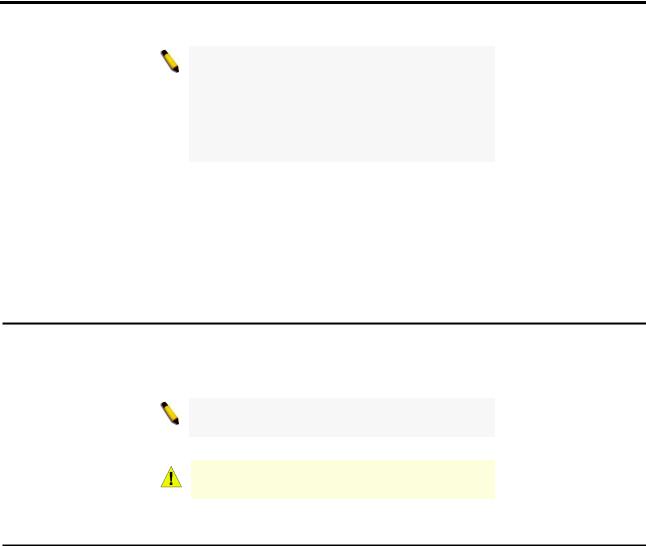
About This Guide |
D-Link Web Smart Switch User Manual |
About This Guide
This guide provides instructions to install the D-Link Gigabit SmartPro Switch DGS-1500-20/28/28P/52, how to use the SmartConsole Utility, and to configure Web-based Management step-by-step.
Note: The model you have purchased may appear slightly different from the illustrations shown in the document. Refer to the Product Instruction and Technical Specification sections for detailed information about your switch, its components, network connections, and technical specifications.
This guide is mainly divided into four parts:
1.Hardware Installation: Step-by-step hardware installation procedures.
2.Getting Started: A startup guide for basic switch installation and settings.
3.Smart Console Utility: An introduction to the central management system.
4.Configuration: Information about the function descriptions and configuration settings.
Terms/Usage
In this guide, the term “Switch” (first letter capitalized) refers to the SmartPro Switch, and “switch” (first letter lower case) refers to other Ethernet switches. Some technologies refer to terms “switch”, “bridge” and “switching hubs” interchangeably, and both are commonly accepted for Ethernet switches.
A NOTE indicates important information that helps a better use of the device.
A CAUTION indicates potential property damage or personal injury.
Copyright and Trademarks
Information in this document is subjected to change without notice. © 2011 D-Link Corporation. All rights reserved.
Reproduction in any manner whatever without the written permission of D-Link Corporation is strictly forbidden.
Trademarks used in this text: D-Link and the D-LINK logo are trademarks of D-Link Corporation; Microsoft and Windows are registered trademarks of Microsoft Corporation.
Other trademarks and trade names may be used in this document to refer to either the entities claiming the marks and names or their products. D-Link Corporation disclaims any proprietary interest in trademarks and trade names other than its own.
1

1 Product Introduction |
D-Link Web Smart Switch User Manual |
1 Product Introduction
Thank you and congratulations on your purchase of D-Link SmartPro Switch Products.
D-Link's next generation SmartPro Ethernet switch series blends plug-and-play simplicity with exceptional value and reliability for small and medium-sized business (SMB) networking. All models are housed in a new style rack-mount metal case with easy-to-view front panel diagnostic LEDs, and provides advance features including four 1000BASE-X SFP slots for fiber connection, network security, traffic segmentation, QoS and versatile management.
Flexible Port Configurations. Four port densities are available for selection: 16, 24, and 48 Gigabit Ethernet ports. Supporting auto-detection of MDI/MDIX, these switches bring inexpensive and easy Ethernet connection to the desktops. DGS-1500 series provides 4 SFP slots, which supports 1000M fiber connections with appropriate fiber transceivers. DGS-1500-28P provides 4 combo SFP slots, which supports both 1000M and 100M fiber connections with appropriate fiber transceivers. The first 24 ports also support up to 15.4 or 30 watts PoE power for the connections of wireless access points, IP phones and other PoE-supported devices, allowing them to be deployed at difficult places such as on high walls and ceilings, where AC power outlets are not readily available.
D-Link Green Technology. D-Link Green devices are about providing eco-friendly alternatives without compromising performance. D-Link Green Technology includes a number of innovations to reduce energy consumption on DGS-1500 series such as reducing power when a port does not have a device attached, or adjusting the power usage according to the Ethernet cable connected to it. For PoE model such as DGS- 1500-28P, D-Link Green Technology offers Time-based PoE feature to shut down per port power off working hours.
Extensive Layer 2 Features. Implemented as complete L2 devices, these switches include functions such as IGMP snooping, port mirroring, Spanning Tree, 802.3ad LACP, SNTP, LLDP and Loopback Detection to enhance performance and network resiliency.
Extensive Layer 3 Features. Implemented as complete L3 devices, these switches include functions such as IP interface, static route, IPv6 Static Route, ARP and single IP management to enhance performance and network resiliency.
QoS. The switches supports bandwidth control and 802.1p priority queues, enabling users to run bandwidthsensitive applications such as streaming multimedia by prioritizing that traffic in network. These functions allow switches to work seamlessly with VLAN and 802.1p traffic and IPv6 traffic class priority in the network.
Network Security. D-Link’s innovative Safeguard Engine function protects the switches against traffic flooding caused by virus attacks. Additional features Storm Control can help to keep the network from being overwhelmed by abnormal traffic. Port Security is another simple but useful authentication method to maintain the network device integrity. Also supports DHCP Server Screening, SSL, SSH and Smart Binding features.
Versatile Management. The new generation of D-Link Web Smart Switches provides growing businesses with a simple and easy management of their network, using an intuitive SmartConsole utility or a Web-Based management interface that allows administrators to remotely control their network down to the port level. The SmartConsole easily allows customers to discover multiple D-Link web smart switches with the same L2 network segment connected to the user’s local PC. With this utility, users do not need to change the IP address of the PC and provide easy initial settings of the smart switches. The switches within the same L2 network segment connected to the user’s local PC are displayed on the screen for instant access. It allows extensive switch configuration settings, and basic configuration of discovered devices, such as a password change or firmware upgrade.
Users can also access the switch via TELNET. Some basic tasks can be performed such as changing the Switch IP address, resetting the settings to factory defaults, setting the administrator password, rebooting the Switch, or upgrading the Switch firmware by using the Command Line Interface (CLI).
2
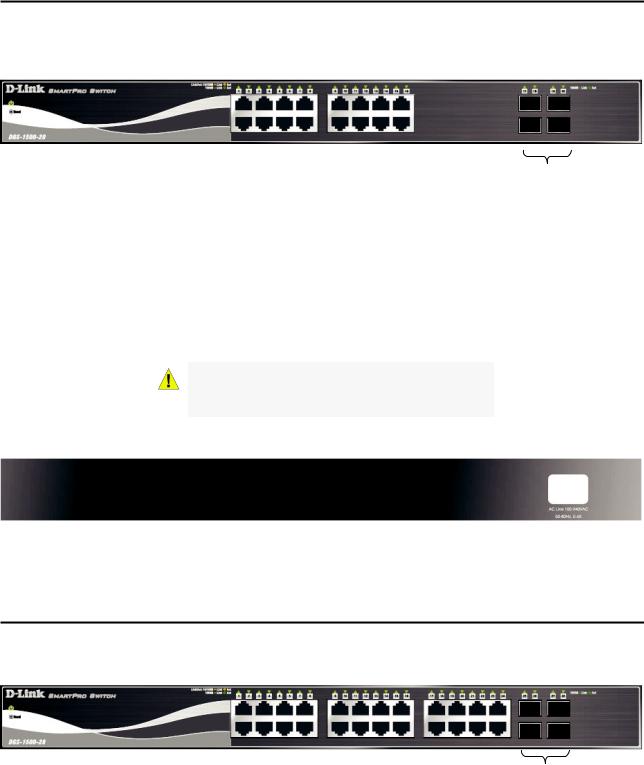
1 Product Introduction |
D-Link Web Smart Switch User Manual |
In addition, users can utilize the SNMP MIB (Management Information Base) to poll the switches for information about the status, or send out traps of abnormal events. SNMP support allows users to integrate the switches with other third-party devices for management in an SNMP-enabled environment. D-Link Web Smart Switches also come with the D-View plug-in module that works with D-View 6 SNMP Management Software, and provides easy-to-use graphic interface and facilitates the operation efficiency.
DGS-1500-20
16-Port 10/100/1000Mbps plus 4 1000Base-T/SFP ports SmartPro Switch.
Front Panel
SFP ports for optical transceivers
Figure 1.1 – DGS-1500-20 Front Panel
Power LED : The Power LED lights up when the Switch is connected to a power source.
: The Power LED lights up when the Switch is connected to a power source.
Reset: By pressing the Reset button, the Switch will change back to the default configuration and all changes will be lost.
Port Link/Act/Speed LED (1-16, 17F, 18F, 19F, 20F): The port LEDs indicate a network link through the corresponding port. Blinking indicates the Switch is either sending or receiving data to the port. When the port LED glows in amber, it indicates the port is running on 10M or 100M. When the port LED glows in green, it is running on 1000Mbps.
CAUTION: The MiniGBIC ports should use UL listed Optical Transceiver product, Rated Laser Class I. 3.3Vdc
Rear Panel
Figure 1.2 – DGS-1500-20 Rear Panel
Power: The power port is where to connect the AC power cord.
DGS-1500-28
24-Port 10/100/1000Mbps plus 4 1000Base-T/SFP ports SmartPro Switch.
Front Panel
SFP ports for optical transceivers
Figure 1.3 – DGS-1500-28 Front Panel
3
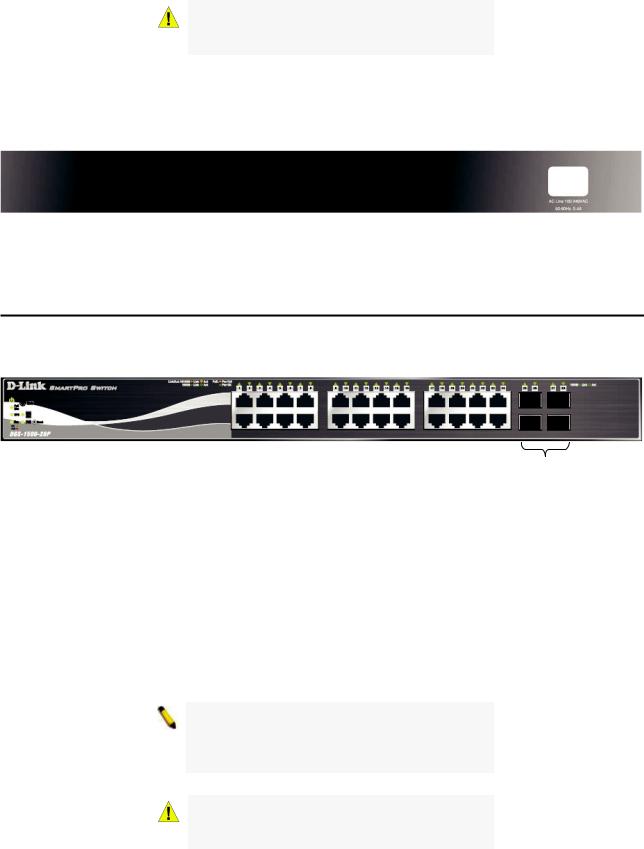
1 Product Introduction |
D-Link Web Smart Switch User Manual |
Power LED : The Power LED lights up when the Switch is connected to a power source.
: The Power LED lights up when the Switch is connected to a power source.
Port Link/Act/Speed LED (1-24, 25F, 26F, 27F, 28F): The Link/Act/Speed LED flashes, which indicates a network link through the corresponding port. Blinking indicates that the Switch is either sending or receiving data to the port. When a port has an amber light, this indicates that the port is running on 10M or 100M. When it has a green light it is running on 1000M.
CAUTION: The MiniGBIC ports should use UL listed Optical Transceiver product, Rated Laser Class I. 3.3Vdc.
Reset: By pressing the Reset button, the Switch will change back to the default configuration and all changes will be lost.
Rear Panel
Figure 1.4 – DGS-1500-28 Rear Panel
Power: The power port is where to connect the AC power cord.
DGS-1500-28P
24-Port 10/100/1000Mbps plus 4 1000Base-T/SFP ports SmartPro PoE Switch.
Front Panel
SFP ports for optical transceivers
Figure 1.5 – DGS-1500-28P Front Panel
Power LED : The Power LED lights up when the Switch is connected to a power source.
: The Power LED lights up when the Switch is connected to a power source.
Pwr Max: The Pwr Max LED lights up when the Switch reaches the maximum power budget defined by the administrator via PoE System Settings page of Web GUI or the default power budget of 78 Watts.
Reset: By pressing the Reset button, the Switch will change back to the default configuration and all changes will be lost.
Mode: By pressing the Mode button, the Port LED will switch between Link/Act and PoE modes.
Port Link/Act/Speed LED (1-24, 25F, 26F, 27F, 28F): The Link/Act/Speed LED flashes, which indicates a network link through the corresponding port. Blinking indicates that the Switch is either sending or receiving data to the port. When a port has an amber light, this indicates that the port is running on 10M or 100M. When it has a green light it is running on 1000Mbps.
Fan: The Fan LED lights green when fans work well, and lights red when fans fail.
NOTE: On DGS-1500-28P, the SFP ports are shared with normal RJ-45 ports 25 to 28. When optical transceiver is inserted to SFP port and link up, the RJ-45 port cannot be used.
CAUTION: The MiniGBIC ports should use UL listed Optical Transceiver product, Rated Laser Class I. 3.3Vdc.
4
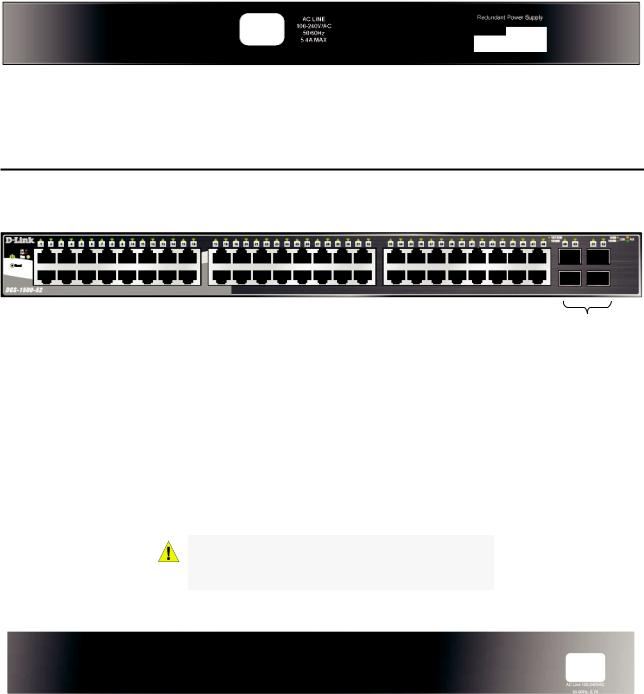
1 Product Introduction |
D-Link Web Smart Switch User Manual |
Port PoE LED (1-24): When mode LED lights up in PoE mode, the port LEDs indicate powering status over the corresponding port.
Rear Panel
Figure 1.6 – DGS-1500-28P Rear Panel
Power: The power port is where to connect the AC power cord.
DGS-1500-52
48-Port 10/100/1000Mbps plus 4 100/1000FX SFP Slot SmartPro Switch.
Front Panel
SFP ports for optical transceivers
Figure 1.7 – DGS-1500-52 Front Panel
Power LED : The Power LED lights up when the Switch is connected to a power source.
: The Power LED lights up when the Switch is connected to a power source.
Port Link/Act/Speed LED (1-48, 49F, 50F, 51F, 52F): The Link/Act/Speed LED flashes, which indicates a network link through the corresponding port. Blinking indicates that the Switch is either sending or receiving data to the port. When a port has an amber light, this indicates that the port is running on 10M or 100M. When it has a green light it is running on 1000M.
Fan: The Fan LED lights green when fans work well, and lights red when fans fail.
Reset: Press the Reset button to reset the Switch back to the default settings. All previous changes will be lost.
CAUTION: The MiniGBIC ports should use UL listed Optical Transceiver product, Rated Laser Class I. 3.3Vdc.
Rear Panel
Figure 1.8 – DGS-1500-52 Rear Panel
Power: Connect the supplied AC power cable to this port.
5
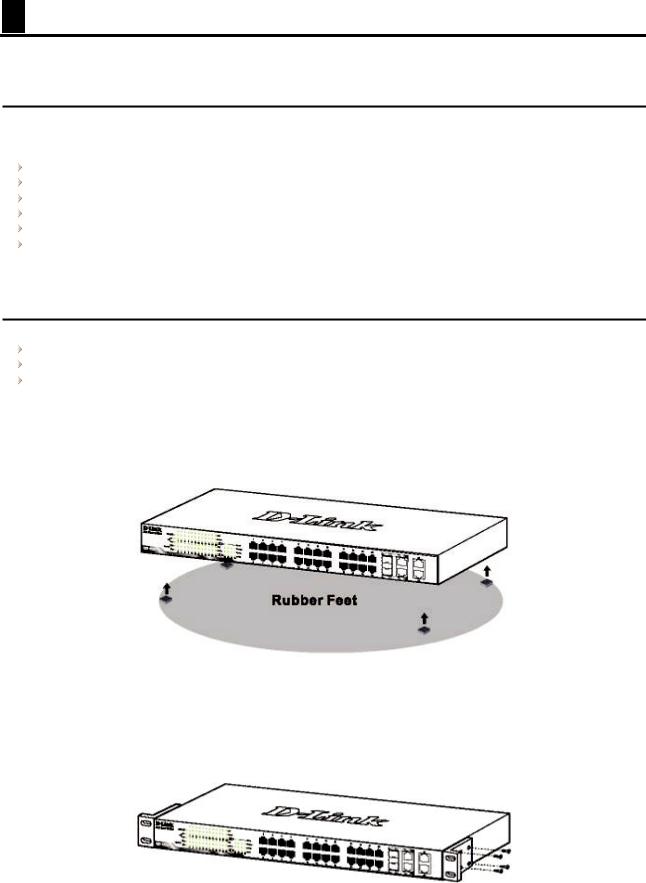
2 Hardware Installation |
D-Link Web Smart Switch User Manual |
2 Hardware Installation
This chapter provides unpacking and installation information for the D-Link SmartPro Switch.
Step 1: Unpacking
Open the shipping carton and carefully unpack its contents. Please consult the packing list located in the User Manual to make sure all items are present and undamaged. If any item is missing or damaged, please contact your local D-Link reseller for replacement.
One D-Link SmartPro Switch
One AC power cord
Four rubber feet
Screws and two mounting brackets
One Multi-lingual Getting Started Guide
One CD with User Manual, SmartConsole Utility program, and D-View Module
If any item is found missing or damaged, please contact the local reseller for replacement.
Step 2: Switch Installation
For safe switch installation and operation, it is recommended that you:
Visually inspect the power cord to see that it is secured fully to the AC power connector. Make sure that there is proper heat dissipation and adequate ventilation around the switch. Do not place heavy objects on the switch.
Desktop or Shelf Installation
When installing the switch on a desktop or shelf, the rubber feet included with the device must be attached on the bottom at each corner of the device’s base. Allow enough ventilation space between the device and the objects around it.
Figure 2.1 – Attach the adhesive rubber pads to the bottom
Rack Installation
The switch can be mounted in an EIA standard size 19-inch rack, which can be placed in a wiring closet with other equipment. To install, attach the mounting brackets to the switch’s side panels (one on each side) and secure them with the screws provided (with 8 M3*6.0 size screws).
Figure 2.2 – Attach the mounting brackets to the Switch
Then, use the screws provided with the equipment rack to mount the switch in the rack.
6
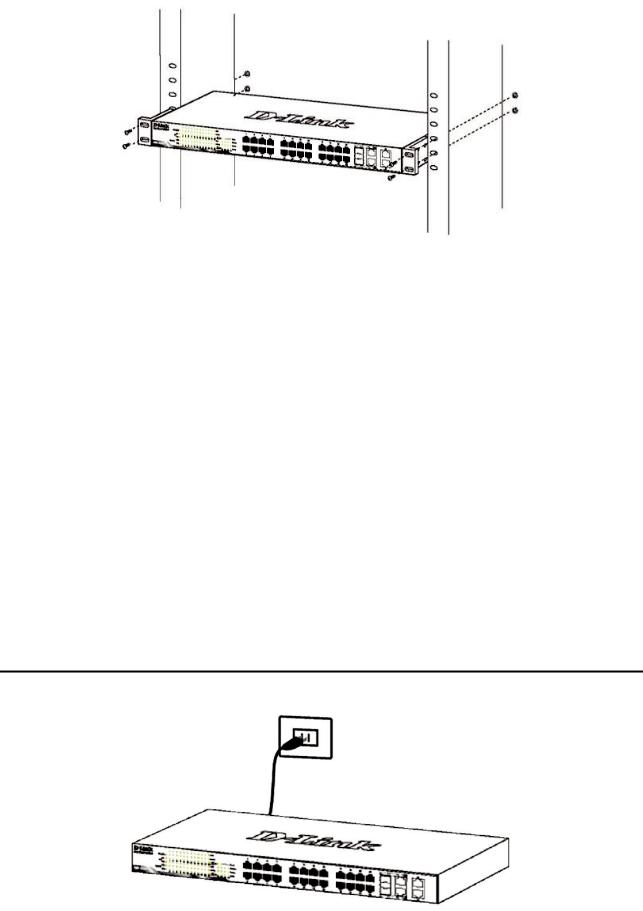
2 Hardware Installation |
D-Link Web Smart Switch User Manual |
Figure 2.3 – Mount the Switch in the rack or chassis
Please be aware of following safety Instructions when installing:
A)Elevated Operating Ambient - If installed in a closed or multi-unit rack assembly, the operating ambient temperature of the rack environment may be greater than room ambient. Therefore, consideration should be given to installing the equipment in an environment compatible with the maximum ambient temperature (Tma) specified by the manufacturer.
B)Reduced Air Flow - Installation of the equipment in a rack should be such that the amount of air flow required for safe operation of the equipment is not compromised.
C)Mechanical Loading - Mounting of the equipment in the rack should be such that a hazardous condition is not achieved due to uneven mechanical loading.
D)Circuit Overloading - Consideration should be given to the connection of the equipment to the supply circuit, and the effect that overloading of the circuits might have on overcurrent protection and supply wiring. Appropriate consideration of equipment nameplate ratings should be used when addressing this concern.
E)Reliable Earthing - Reliable earthing of rack-mounted equipment should be maintained. Particular attention should be given to supply connections other than direct connections to the branch circuit (e.g. use of power strips)."
Step 3 – Plugging in the AC Power Cord
Users may now connect the AC power cord into the rear of the switch and to an electrical outlet (preferably one that is grounded and surge protected).
Figure 2.4 –Plugging the switch into an outlet
7
2 Hardware Installation |
D-Link Web Smart Switch User Manual |
Power Failure
As a precaution, the switch should be unplugged in case of power failure. When power is resumed, plug the switch back in.
8
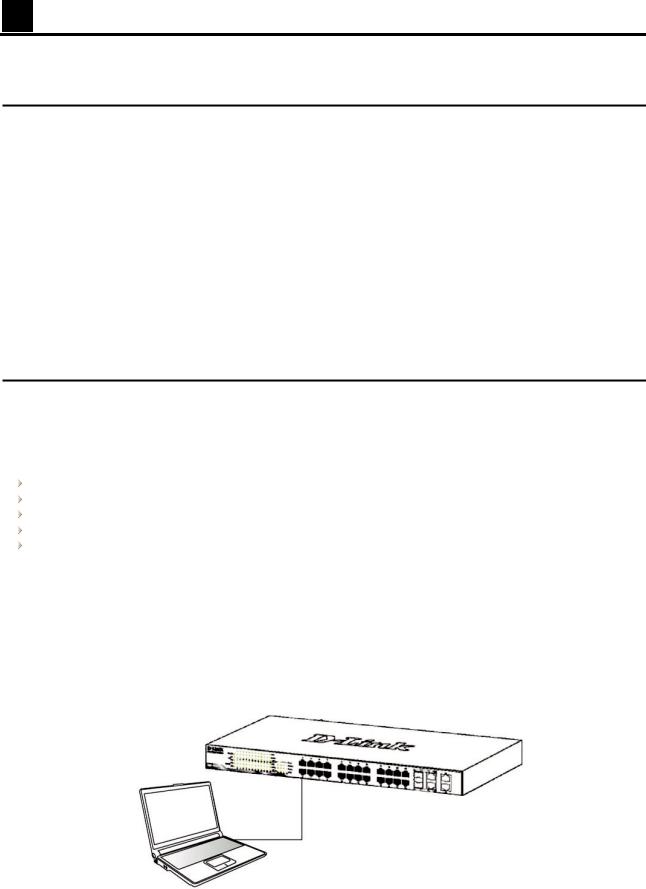
3 Getting Started |
D-Link Web Smart Switch User Manual |
3 Getting Started
This chapter introduces the management interface of D-Link SmartPro Switch.
Management Options
The D-Link SmartPro Switch can be managed through any port on the device by using the Web-based Management, or through any PC using the SmartConsole Utility or CLI commands.
Each switch must be assigned its own IP Address, which is used for communication with the Web-Based Management or a SNMP network manager. The PC should have an IP address in the same range as the switch. Each switch can allow up to four users to access the Web-Based Management concurrently.
However, if you want to manage multiple D-Link SmartPro Switches, the SmartConsole Utility and Single IP Management are more convenient choice. By using the SmartConsole Utility, you do not need to change the IP address of your PC and it is easier to initialize multiple Smart Switches.
Please refer to the following installation instructions for the Web-based Management and the SmartConsole Utility.
Using Web-based Management
After a successful physical installation, you can configure the Switch, monitor the network status, and display statistics using a web browser.
Supported Web Browsers
The embedded Web-based Management currently supports the following web browsers:
Internet Explorer 6 or later version
Netscape 8 or later version
Chrome 5.0 or later version
Firefox 3.0 or later version Opera 10 or later version
Connecting to the Switch
You will need the following equipment to begin the web configuration of your device:
1.A PC with a RJ-45 Ethernet connection
2.A standard Ethernet cable
Connect the Ethernet cable to any of the ports on the front panel of the switch and to the Ethernet port on the PC.
Figure 3.1 – Connected Ethernet cable
9

3 Getting Started |
D-Link Web Smart Switch User Manual |
Login Web-based Management
In order to login and configure the switch via an Ethernet connection, the PC must have an IP address in the same subnet as the switch. For example, if the switch has an IP address of 10.90.90.90, the PC should have an IP address of 10.x.y.z (where x/y is a number between 0 ~ 254 and z is a number between 1 ~ 254), and a subnet mask of 255.0.0.0. There are two ways to launch the Web-based Management, you may either click the Web Access button at the top of the SmartConsole Utility or open the web browser and enter 10.90.90.90 (the factory-default IP address) in the address bar. Then press <Enter>.
Figure 3.2 –Enter the IP address 10.90.90.90 in the web browser
NOTE: The switch's factory default IP address is 10.90.90.90 with a subnet mask of 255.0.0.0 and a default gateway of 0.0.0.0.
The web configuration can also be accessed through the SmartConsole Utility. Open the SmartConsole Utility and double-click the switch as it appears in the Monitor List. This will automatically load the web configuration in your web browser.
When the following logon dialog box appears, enter the password and choose the language of the Webbased Management interface then click OK.
The switch supports 10 languages including English, Traditional Chinese, Simplified Chinese, German, Spanish, French, Italian, Portuguese, Japanese and Russian. By default, the password is admin and the language is English.
Figure 3.3 – Logon Dialog Box
Smart Wizard
After a successful login, the Smart Wizard will guide you through essential settings of the D-Link Web Smart Switch. Please refer to the Smart Wizard Configuration section for details.
Web-based Management
By clicking the Exit button in the Smart Wizard, you will enter the Web-based Management interface. Please refer to Chapter 5 Configuration for detailed instructions.
SmartConsole Utility
The SmartConsole Utility included in the installation CD is a program for discovering D-Link Smart Switches within the same network segment connected to your PC. This tool is only for computers running Windows 2000, Windows XP, Windows 7, or Windows Vista operating systems. There are two options for the installation of the SmartConsole Utility; one is through the autorun program on the installation CD and the other is manual installation.
10

3 Getting Started |
D-Link Web Smart Switch User Manual |
NOTE: Please be sure to uninstall any existing SmartConsole Utility from your PC before installing the latest SmartConsole Utility.
Option 1: Follow these steps to install the SmartConsole Utility via the autorun program on the installation CD.
1.Insert the Utility CD into your CD-Rom/DVD-Rom Drive.
2.The autorun program will appear automatically.
3.Click on the ”Install SmartConsole Utility” button and an installation wizard will guide you through the process.
4.After successfully installing the SmartConsole Utility, you can open the utility by clicking Start > Programs > D-Link SmartConsole Utility.
5.Connect the Smart Switch to the same L2 network segment of your PC and use the SmartConsole Utility to discover the Smart Switches.
Option 2: Follow these steps to install the SmartConsole Utility manually.
1.Insert the Utility CD into your CD-Rom/DVD-Rom Drive.
2.From the Start menu on the Windows desktop, click Run.
3.In the Run dialog box, type D:\D-Link SmartConsole Utility\D-Link_SmartConsole_Utility_v3.00.10.exe (where D:\ represents the drive letter of your CD-Rom) and click OK.
4.Follow the on-screen instructions to install the utility.
5.Upon completion, go to Start > Programs > D-Link SmartConsole Utility and open the SmartConsole Utility.
6.Connect the Smart Switch to the same L2 network segment of your PC and use the SmartConsole Utility to discover the Smart Switches.
For detailed explanations of SmartConsole’s functions, please refer to Chapter 4 SmartConsole Utility
NOTE: The current SmartConsole Utility does not support IPv6 feature. Please be sure to install the SmartConsole Utility from you PC with IPv4 address. After installed SmartConsole Utility, then it can discover the DGS-1500 series with IPv6 address.
11

4 SmartConsole Utility |
D-Link Web Smart Switch User Manual |
4 SmartConsole Utility
The D-Link SmartConsole Utility allows the administrator to quickly discover all D-Link smart switches, which are in the same domain of the PC, collect traps and log messages, and quick access to basic configurations of the switch.
The SmartConsole Utility consists of three parts, Device Configurations at the top, Device List as the main body, and SmartConsole Settings at the left.
Figure 4.1 – SmartConsole Utility
SmartConsole Settings
The SmartConsole Settings at the left has five icons, Utility Settings, Log, Trap, Monitor list, and About.
Utility Settings
Click this icon to launch the Utility Settings window. Refresh time refreshes the devices, which were selected as monitored devices in the Device List. Choices include 15 secs, 30 secs, 1 mins, 2 mins, and 5 mins for selecting the monitoring time intervals. Utility Group Interval establishes the intervals (in seconds) that the Switch will be discovered in the SmartConsole Device List.
Figure 4.2 – SmartConsole Utility Settings
NOTE: If the Group Interval is set to 0, IGMP
Snooping must be disabled in the Switch, or the
SmartPro Switch will not be discovered.
Log
Click this icon to launch the Log window. Click View Log to show the events of the SmartConsole Utility and the device. Time indicates when the message was received, Location indicates where the message was
12
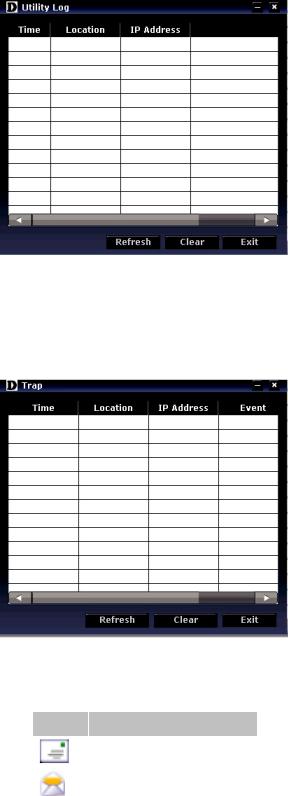
4 SmartConsole Utility |
D-Link Web Smart Switch User Manual |
received and IP Address denotes where it comes from. Click Refresh to redisplay all log entries, click Clear to clear all log entries. Click Exit to exit.
Figure 4.3 – SmartConsole Log
Trap
Click this icon to launch the Trap window. Click View Trap to show the events of the SmartConsole Utility and the device. Time indicates when the trap message was received, Location indicates where the trap message was received, IP denotes where it comes from and Event shows the content of this trap message. Click Refresh to redisplay all traps, click Clear to clear all entries. Click Exit to exit
Figure 4.4 – SmartConsole Trap
The trap icon in the SmartConsole Settings will change while receiving new trap messages. Please see below for detailed description.
Icon Description
No new traps
New traps was received
Monitor List
By clicking on this icon you will see below options:
13
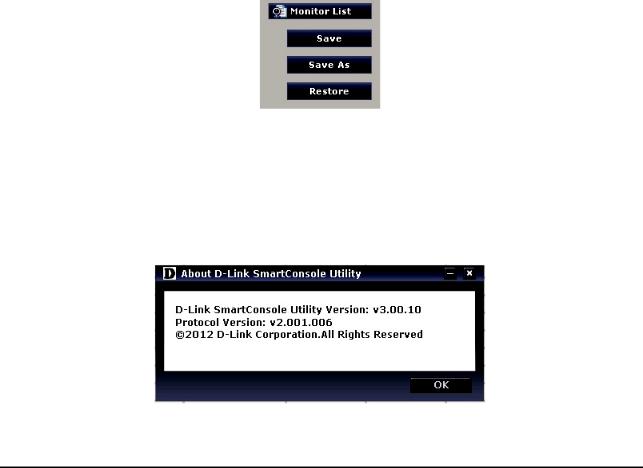
4 SmartConsole Utility |
D-Link Web Smart Switch User Manual |
Figure 4.5 – SmartConsole Monitor List
Save: Records the setting of the Device List as default for the next time the SmartConsole Utility is used. Save As: Records the setting of the Device List in an appointed filename and file path.
Restore: Manually reload a Device List setting file.
About
Click this icon to launch the SmartConsole Info window.
Figure 4.6 – SmartConsole About
Device Configuration
The Device Configuration in the SmartConsole Utility has five icons:  Device Settings
Device Settings
 Password Settings
Password Settings
 Firmware Upgrade
Firmware Upgrade
 DHCP Refresh
DHCP Refresh
 Web Access
Web Access
and the  ,
,  ,
,  device buttons for the Device List.
device buttons for the Device List.
 Device Settings
Device Settings
Select a switch from the Device List. Click on this icon to launch the Device Settings window. Here you can configure the Product Name, MAC Address, IPv4 Address, Subnet Mask, Gateway, System Name, Location, Trap IP, Group Interval, and DHCP Client Setting of the Switch.
To apply the configuration, insert the correct device password in the Confirm Password box and then click
OK.
14
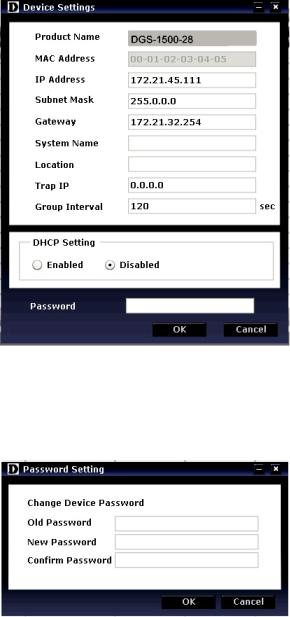
4 SmartConsole Utility |
D-Link Web Smart Switch User Manual |
Figure 4.7 – SmartConsole Device Settings
 Password Settings
Password Settings
Select a switch from the Device List. Click on this icon to launch the Device Password Manager window. Here you can enter a new password and confirm it.
Figure 4.8 – SmartConsole Password Settings
 Firmware Upgrade
Firmware Upgrade
Select one or many switches of the same model name from the Device List. Click on this icon to launch the Firmware Upgrade window. Specify the Firmware Path (or Browse for one) that you are going to use. Input the correct password of the device, and then click Upgrade. The state will show "OK" after completion, or “Fail” if the firmware upgrade fails or cannot be completed for any reason.
15
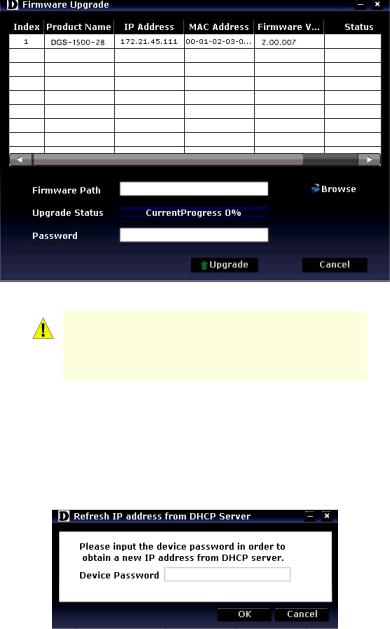
4 SmartConsole Utility |
D-Link Web Smart Switch User Manual |
Figure 4.9 – Firmware Upgrade
CAUTION: Do not disconnect the PC or remove the power cord from the device until the upgrade completes. The software may be corrupted because of the incomplete firmware upgrade.
 DHCP Refresh:
DHCP Refresh:
If a DHCP-client enabled switch in the Device List shows the default IP is still used, it means the device did not receive an IPv4 address from the DHCP server successfully. Select that switch and click the DHCP refresh icon. Enter the correct Device Password and then click OK. The device will renew the IPv4 address from the DHCP server.
Figure 4.10 – DHCP Refresh
 Web Access
Web Access
Select a switch from the Device List. Click this icon to launch your Internet browser (eg. The Internet Explorer). Here you can configure the Switch through the Web-based Management utility. You may also get into the Web-based Management by double-clicking the device in the device list.
Add(+), Delete(-) and Discover the device
Click the Discovery button to display all of the Web-Smart devices located in the same domain with the management PC.
Click the + and insert a device IP address to add a device into the Discover List, or select a device and click the – button to remove it.
16
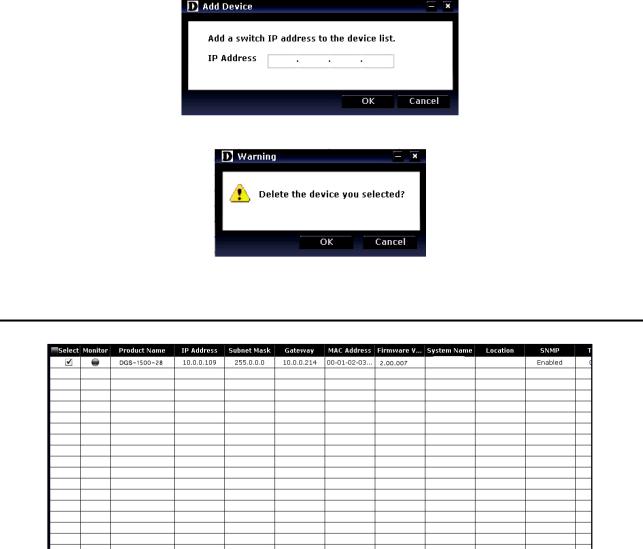
4 SmartConsole Utility |
D-Link Web Smart Switch User Manual |
Figure 4.11 – SmartConsole Add device
Figure 4.12 – SmartConsole Delete device
Device List
This list displays all discovered Web-Smart devices on the network.
Figure 4.13 – SmartConsole Device List
Definitions of the Device List features:
Select: Click the Select to choose a switch for configuration settings.
Monitor: Click the Monitor button and the SmartConsole will collect the trap and log data from the device.
The  in the monitor means the device was discovered by SmartConsole. Click the icon to have the device to continue updating the information, such as system log or trap to the SmartConsole Utility. The icon
in the monitor means the device was discovered by SmartConsole. Click the icon to have the device to continue updating the information, such as system log or trap to the SmartConsole Utility. The icon
will appear . When the device was detected as not reachable, the icon will change to
. When the device was detected as not reachable, the icon will change to . Please check if the power or the cable of this device is disconnected.
. Please check if the power or the cable of this device is disconnected.
Product Name: Displays the device product name.
IP Address: Displays the current IP addresses of devices. Subnet Mask: Displays the Subnet Mask setting of the device. Gateway: Displays the Gateway setting of the device.
MAC Address: Displays the device MAC Addresses.
Firmware version: Displays the current Firmware version of this device. System Name: Displays the appointed device system name.
Location: Displays the location of the appointed device. SNMP: Displays the SNMP status of the device.
Trap IP: Displays the IP address of the host where the Trap information will be sent. DHCP: Specify if the device gets the IP address from a DHCP server.
17

4 SmartConsole Utility |
D-Link Web Smart Switch User Manual |
Group Interval: Displays the intervals (in seconds) that the Switch will be discovered in the SmartConsole Device List.
NOTE: If the devices are marked red in the device list, it means that a firmware upgrade is required again.
NOTE: If the IP address of device is showed with IPv6 address, then it can not be configured with Smartconsole Utility. The user needs to double click the selected device and login the web for configuration.
18

5 Configuration |
D-Link Web Smart Switch User Manual |
5 Configuration
The features and functions of the D-Link SmartPro Switch can be configured for optimum use through the Web-based Management Utility.
Smart Wizard Configuration
After a successful login, the Smart Wizard will guide you through essential settings of the D-Link Web Smart Switch. If you do not plan to change anything, click Exit to leave the Wizard and enter the Web Interface. You can also skip it by clicking Don’t show Smart Wizard next time for the next time you logon to the Webbased Management.
IPv4 Information
IPv4 Information will guide you to do basic configurations on 3 steps for the IP Information, access password, and SNMP. Select Static, DHCP or BOOTP, and type the desired new IP Address, select the Netmask and type the Gateway address, then click the Apply button to enter the next Password setting page. (No need to enter IP Address, Netmask and Gateway of DHCP and BOOTP selection.) The IP address is allowed for IPv4 and IPv6 address. If you are not changing the settings, click Exit button to go back to the main page. Or you can click on Ignore the wizard next time to skip wizard setting when the switch boots up.
Figure 5.1 – IPv4 Information in Smart Wizard
NOTE: The IPv4 Information of Smart Wizard does not support IPv6 address.
Password Settings
Type the desired new password in the Password box and again in the Confirm Password, then click the Next button to the SNMP setting page.
19
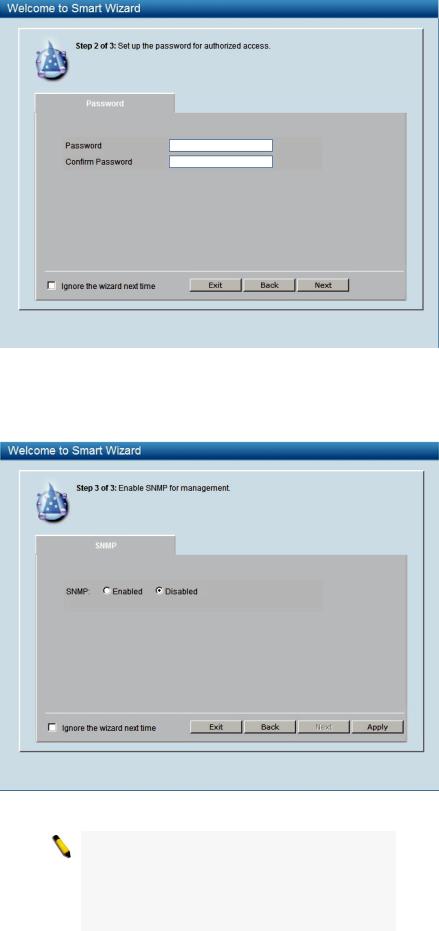
5 Configuration |
D-Link Web Smart Switch User Manual |
Figure 5.2 – Password setting in Smart Wizard
SNMP Settings
The SNMP Setting allows you to quickly enable/disable the SNMP function. The default SNMP Setting is Disabled. Click Enabled and then click Apply to make it effective.
Figure 5.3 – SNMP Setting in Smart Wizard
NOTE: Changing the system IP address will disconnect you from the current connection. Please enter the correct IP address in the Web browser again and make sure your PC is in the same subnet with the switch. See Login Webbased Management for a detailed description.
20
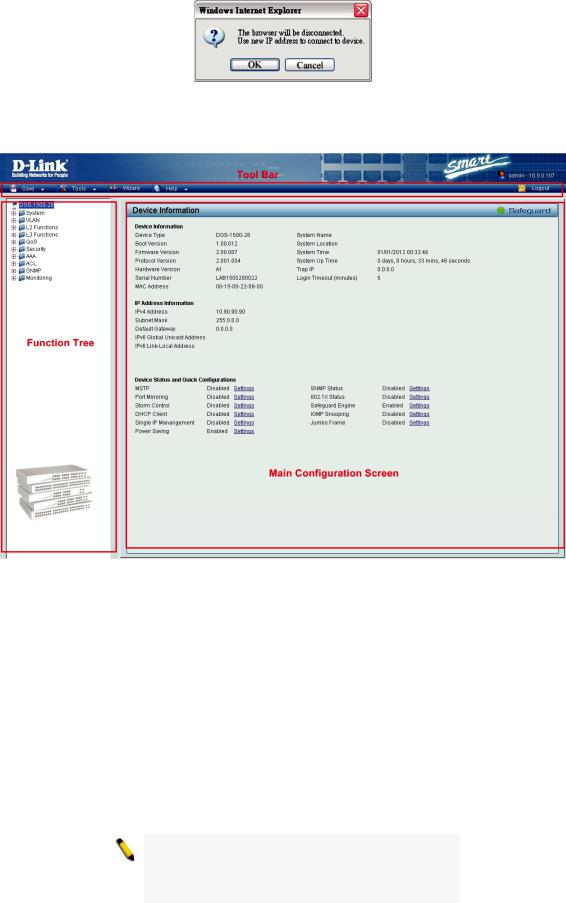
5 Configuration |
D-Link Web Smart Switch User Manual |
If you want to change the IP settings, click OK and start a new web browser.
Figure 9 – Confirm the changes of IP address in Smart Wizard
Web-based Management
After clicking the Exit button in Smart Wizard you will see the screen below:
Figure 5.4 – Web-based Management
The above image is the Web-based Management screen. The three main areas are the Tool Bar on top, the
Function Tree, and the Main Configuration Screen.
The Tool Bar provides a quick and convenient way for essential utility functions like firmware and configuration management.
By choosing different functions in the Function Tree, you can change all the settings in the Main Configuration Screen. The main configuration screen will show the current status of your Switch by clicking the model name on top of the function tree.
At the upper right corner of the screen the username and current IP address will be displayed.
Under the username is the Logout button. Click this to end this session.
NOTE: If you close the web browser without clicking the Logout button first, then it will be seen as an abnormal exit and the login session will still be occupied.
21
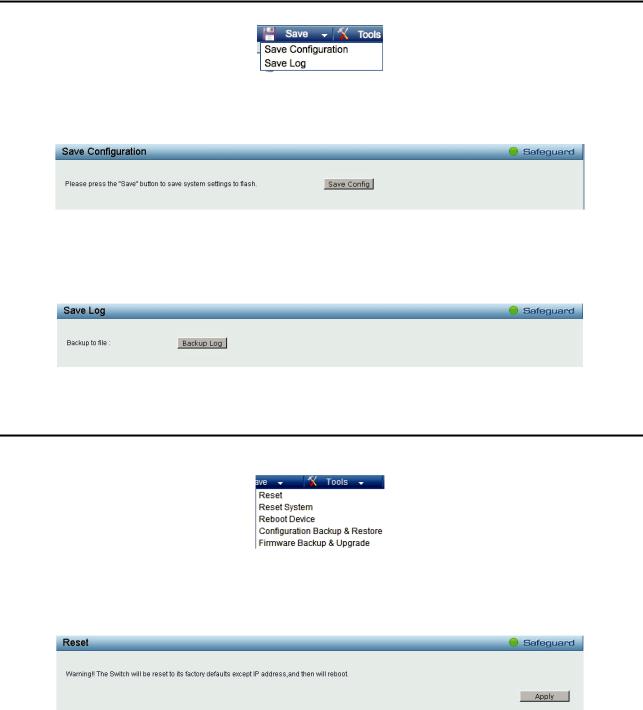
5 Configuration |
D-Link Web Smart Switch User Manual |
Finally, by clicking on the D-Link logo at the upper-left corner of the screen you will be redirected to the local D-Link website.
Tool Bar > Save Menu
The Save Menu provides Save Configuration and Save Log functions.
Figure 5.5 – Save Menu
Save Configuration
Select to save the entire configuration changes you have made to the device to switch’s non-volatile RAM.
Figure 5.6 – Save Configuration
Save Log
Save the log entries to your local drive and a pop-up message will prompt you for the file path. You can view or edit the log file by using text editor (e.g. Notepad).
Figure 5.7 – Save Log
Tool Bar > Tool Menu
The Tool Menu offers global function controls such as Reset, Reset System, Reboot Device, Configuration Backup and Restore, Firmware Backup and Upgrade.
Figure 5.8 – Tool Menu
Reset
Provide a safe reset option for the Switch. All configuration settings in non-volatile RAM will be reset to factory default except for the IP address.
Figure 5.9 – Tool Menu > Reset
Reset System
Provide another safe reset option for the Switch. All configuration settings in non-volatile RAM will reset to factory default and the Switch will reboot.
22

5 Configuration |
D-Link Web Smart Switch User Manual |
Figure 5.10 – Tool Menu > Reset System
Reboot Device
Provide a safe way to reboot the system. Click Reboot to restart the switch.
Figure 5.11 – Tool Menu > Reboot Device
Configuration Backup and Restore
Allow the current configuration settings to be saved to a file (not including the password), and if necessary, you can restore configuration settings from this file. Two methods can be selected: HTTP or TFTP.
Figure 5.12 – Tool Menu > Configure Backup and Restore
HTTP: Backup or restore the configuration file to or from your local drive.
Click Backup to save the current settings to your disk.
Click Browse to browse your inventories for a saved backup settings file.
Click Restore after selecting the backup settings file you want to restore.
TFTP: TFTP (Trivial File Transfer Protocol) is a file transfer protocol that allows you to transfer files to a remote TFTP server. Select IPv4 or IPv6 and specify TFTP Server IP Address and TFTP File Name for the configuration file you want to save to / restore from. The maximum Telnet Server connection is 4.
Click Backup to save the current settings to the TFTP server.
Click Restore after selecting the backup settings file you want to restore.
Note: Switch will reboot after restore, and all current configurations will be lost
Firmware Backup and Upgrade
Allow for the firmware to be saved, or for an existing firmware file to be uploaded to the Switch. Two methods can be selected: HTTP or TFTP.
23
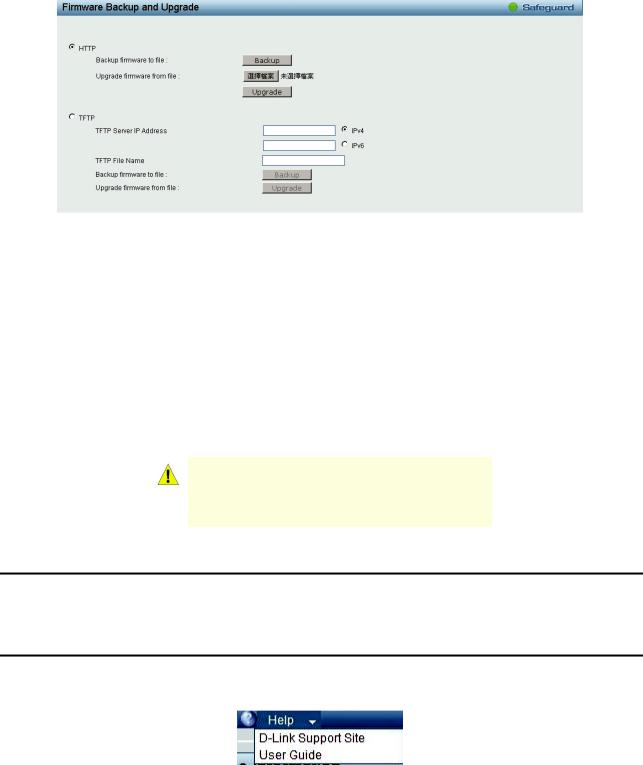
5 Configuration |
D-Link Web Smart Switch User Manual |
Figure 5.13 – Tool Menu > Firmware Backup and Upload
HTTP: Backup or upgrade the firmware to or from your local PC drive.
Click Backup to save the firmware to your disk.
Click Browse to browse your inventories for a saved firmware file.
Click Upgrade after selecting the firmware file you want to restore.
TFTP: Backup or upgrade the firmware to or from a remote TFTP server. Select IPv4 or IPv6 and specify TFTP Server IP Address and TFTP File Name for the configuration file you want to save to / restore from. The maximum Telnet Server connection is 4.
Click Backup to save the firmware to the TFTP server.
Click Upgrade after selecting the firmware file you want to restore.
CAUTION: Do not disconnect the PC or remove the power cord from device until the upgrade completes. The Switch may crash if the Firmware upgrade is incomplete.
Tool Bar > Smart Wizard
By clicking the Smart Wizard button, you can return to the Smart Wizard if you wish to make any changes there.
Tool Bar > Online Help
The Online Help provides two ways of online support: Online Support Site will lead you to the D-Link website where you can find online resources such as updated firmware images; User Guide can offer an immediate reference for the feature definition or configuration guide.
Figure 5.14 – Online Help
24
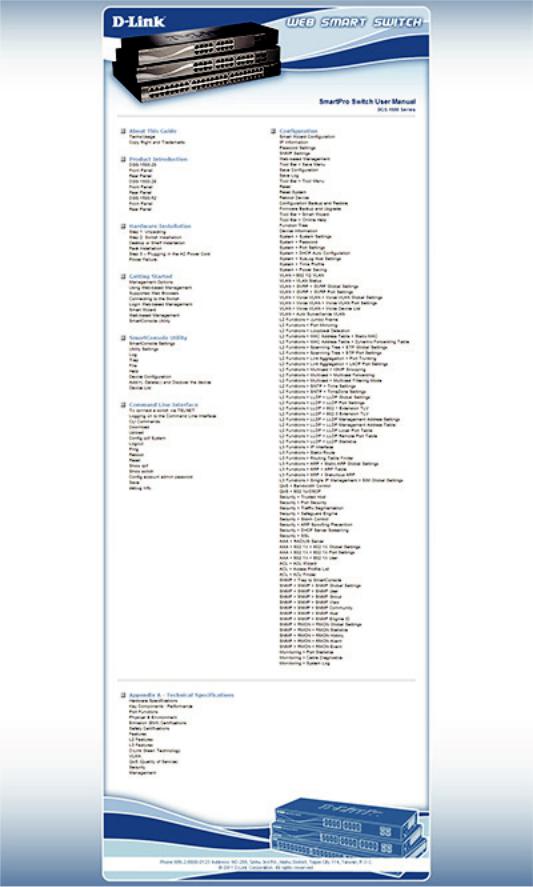
5 Configuration |
D-Link Web Smart Switch User Manual |
Figure 5.15 – User Guide Micro Site
25
